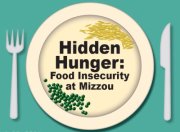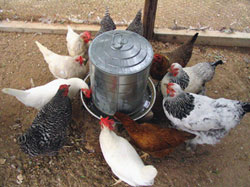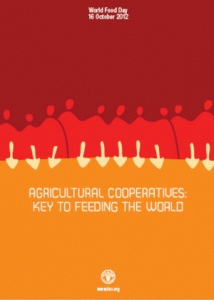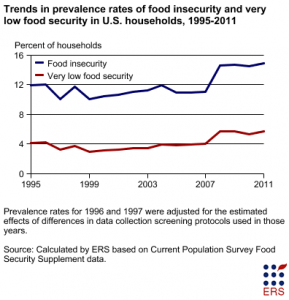
April 29, 2013
Can $4 a day provide a nutritious diet?
That is the question posed by the Health Communication Research Center, a partner of the Interdisciplinary Center for Food Security, as their staff embarked on the Food Stamp Challenge in March. Limiting food expenditures to $28 dollars per week (the average SNAP benefit for a person in Missouri), they set out to learn about the challenges of eating healthy on a food stamp budget and shared their experiences on the their blog. The challenge coincides with National Nutrition Month and the release of the documentary, A Place at the Table. The Health Communication Research Center at the…

April 11, 2013
Hidden Hunger at Mizzou
Hunger on college campuses is often overlooked, but with increasing costs for tuition and housing, students often find themselves pinched. Students at the University of Missouri recently organized an event to bring the issue to light. Co-hosted by the Women’s Center, Tiger Pantry (MU’s campus-based food pantry), and the Environmental Leadership Office, Hidden Hunger included a panel of MU students who shared their personal stories about dealing with food insecurity. Ashley Vancil, a graduate student with the Interdisciplinary Center for Food Security, moderated the panel. More information about the forum can be found at the Maneater and…

March 26, 2013
Poverty Summit Brings Together Advocates and Experts
The 2013 Poverty Summit, sponsored by Missourians to End Poverty, took place on April 9th in Jefferson City, Missouri. The summit provided an opportunity for organizations and advocates from across the state to network, learn from one another, and develop strategies for addressing poverty in Missouri. This year’s summit featured the notable Peter Edelman, author of So Rich So Poor: Why It’s So Hard to End Poverty in America, who discussed issues related to wealth disparities, unemployment, and the working poor. Other featured speakers included Eileen Wallace and Gene Nichol. More information about the summit can…
![Belo Horizonte, Brazil - By Benjamin Thompson (Flickr: Belo Horizonte, Brazil) [CC-BY-SA-2.0 (http://creativecommons.org/licenses/by-sa/2.0)], via Wikimedia Commons](https://foodsecurity.missouri.edu/wp-content/uploads/2012/12/Belo_Horizonte_Brazil_builgins-300x199.jpg)
Dec. 13, 2012
The City that Ended Hunger
A Yes magazine article by Frances Moore Lappé tells the story of how Brazil’s fourth largest city, Belo Horizonte, tackled the issue of hunger. Using a combination of policy and market measures, along with citizen engagement, the city reached nearly 40 percent of it’s 2.5 million citizens through various hunger relief and nutrition efforts and reduced infant mortality by half over a 10 year period. In particular, the city worked to link local farmers with consumers through the establishment of farmers’ markets, used pricing schemes to make certain fruits and vegetables more affordable, and established “People’s Restaurants” (Restaurante…

Dec. 5, 2012
Community Food Systems and Food Banks
The Community Food Resource Center, part of the Community Food Bank of Southern Arizona, stands out for their efforts to incorporate programs and projects that link people to community-based food systems. They have active home and community gardening programs, a 2.5 acre urban farm, and farmers’ markets that provide a source of fresh food to the community. The Resource Center also supports a unique Community Food Consignment Program which enables home gardeners and small farmers to consign their produce for sale at local farmers’ markets. Robert Ojeda, vice president of the Community Food Resource Center, was recently…

Oct. 16, 2012
World Food Day 2012
October 16 was World Food Day, sponsored by a host of government agencies and non-governmental organizations to raise awareness about hunger and malnutrition around the world. According to a recent report jointly published by the United Nations Food and Agriculture Organization (FAO), the International Fund for Agricultural Development (IFAD), and the World Food Programme (WFP), approximately 870 million people, or one in eight, were suffering from chronic undernourishment in 2010 through 2012. The report notes that while the number of hungry people declined between 1990 and 2007, efforts to reduce hunger have slowed since 2007. The theme…

Oct. 2, 2012
Can these Minnesota ads reduce obesity?
Minnesotans have something new to watch on TV: Commercials encouraging them to reduce their weight. They are a part of the Blue Cross Blue Shield of Minnesota’s latest campaign to reduce obesity rates. These ads haven’t been universally loved, drawing criticism from those who argue that people respond better to positive message about health and healthy eating rather than negative ones. The insurance company is defending the ads. The ads can be viewed in Ezra Klein’s Wonkblog post at the Washington Post.

Oct. 2, 2012
Catching up with the Columbia Center for Urban Agriculture
The Columbia Center for Urban Agriculture, a non-profit organization in Columbia, Missouri, has been working to expand fresh food options in central Columbia since 2008. The group began with a small demonstration garden and has grown to include a 1.3 acre urban farm, an on-site farm stand that accepts SNAP benefits, an Opportunity Gardens program (helping people install and maintain vegetable gardens at their homes), youth gardening education, a landscaping division, and more. The Columbia Daily Tribune recently caught up with the group just before their 3rd Annual Harvest Hootenanny Fundraiser. Read the rest of the story.

Oct. 2, 2012
NPR: Recession Still Hurting U.S. Families Trying To Put Food On The Table
A recent post on NPR’s food blog, The Salt, reported that “the number of U.S. families struggling to put enough food on the table remains at record-high levels.” This comes from new data released by the U.S. Department of Agriculture. The department estimates that approximately 14.9 percent of American households were food insecure in 2011. Of those 5.7 percent had very low food security, meaning that food intake by some household members was reduced or disrupted at times during the year. Food insecurity levels are nearly the same as in 2010 and have remained at this level since…
- « Previous
- 1
- 2